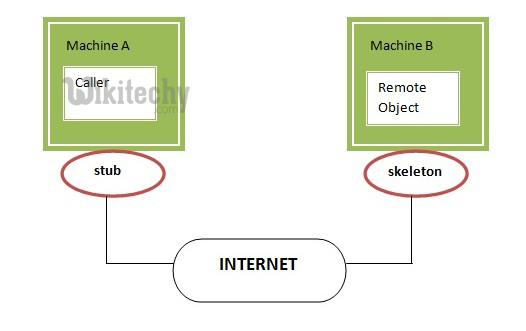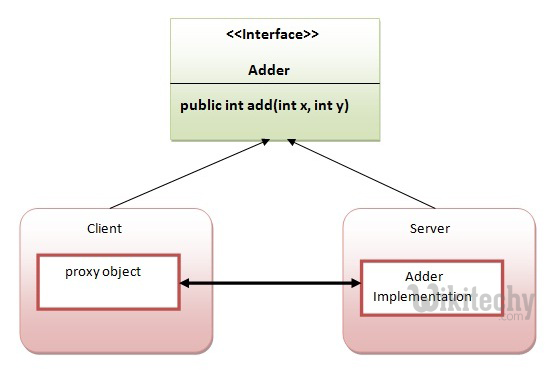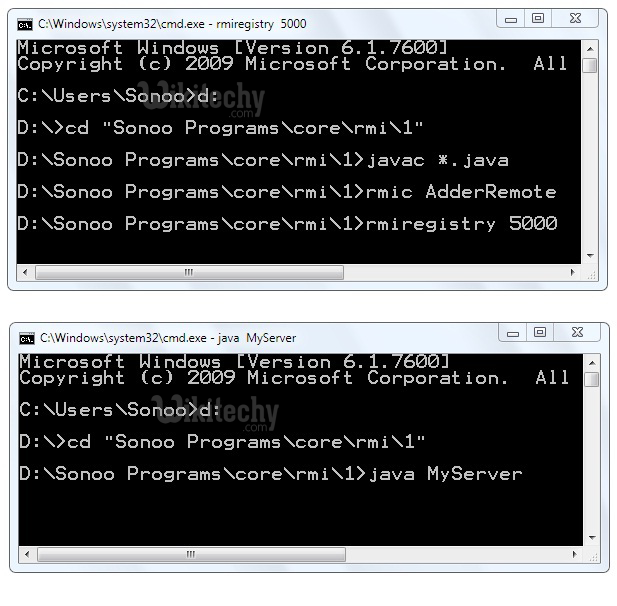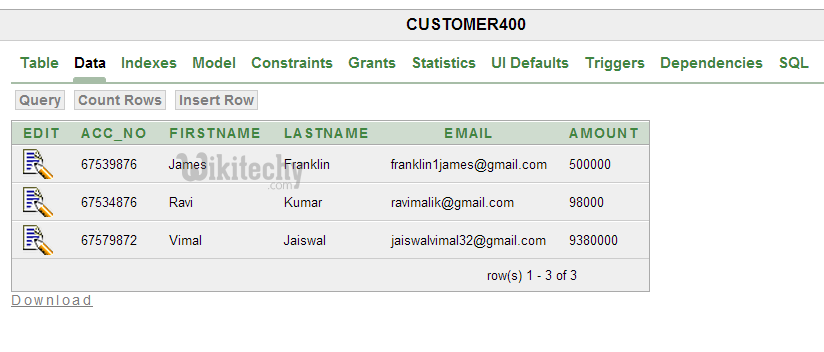java tutorial - RMI (Remote Method Invocation) - java programming - learn java - java basics - java for beginners
The RMI (Remote Method Invocation) is an API that provides a mechanism to create distributed application in java. The RMI allows an object to invoke methods on an object running in another JVM
- The RMI provides remote communication between the applications using two objects stub and skeleton.
Understanding stub and skeleton
- RMI uses stub and skeleton object for communication with the remote object.
- A remote object is an object whose method can be invoked from another JVM. Let's understand the stub and skeleton objects:
stub
The stub is an object, acts as a gateway for the client side. All the outgoing requests are routed through it. It resides at the client side and represents the remote object. When the caller invokes method on the stub object, it does the following tasks:
- It initiates a connection with remote Virtual Machine (JVM),
- It writes and transmits (marshals) the parameters to the remote Virtual Machine (JVM),
- It waits for the result
- It reads (unmarshals) the return value or exception, and
- It finally, returns the value to the caller.
skeleton
The skeleton is an object, acts as a gateway for the server side object. All the incoming requests are routed through it. When the skeleton receives the incoming request, it does the following tasks:
- It reads the parameter for the remote method
- It invokes the method on the actual remote object, and
- It writes and transmits (marshals) the result to the caller
In the Java 2 SDK, an stub protocol was introduced that eliminates the need for skeletons.

Learn java - java tutorial - stuband skeleton - java examples - java programs
Understanding requirements for the distributed applications
If any application performs these tasks, it can be distributed application.
- The application need to locate the remote method
- It need to provide the communication with the remote objects, and
- The application need to load the class definitions for the objects.
The RMI application have all these features, so it is called the distributed application.
Java RMI Example
The is given the 6 steps to write the RMI program.
- Create the remote interface
- Provide the implementation of the remote interface
- Compile the implementation class and create the stub and skeleton objects using the rmic tool
- Start the registry service by rmiregistry tool
- Create and start the remote application
- Create and start the client application
RMI Example
- In this example, we have followed all the 6 steps to create and run the rmi application.
- The client application need only two files, remote interface and client application. In the rmi application, both client and server interacts with the remote interface.
- The client application invokes methods on the proxy object, RMI sends the request to the remote JVM.
- The return value is sent back to the proxy object and then to the client application.

Learn java - java tutorial - rmiex - java examples - java programs
1) create the remote interface
- For creating the remote interface, extend the Remote interface and declare the RemoteException with all the methods of the remote interface.
- Here, we are creating a remote interface that extends the Remote interface. There is only one method named add() and it declares RemoteException.
import java.rmi.*;
public interface Adder extends Remote{
public int add(int x,int y)throws RemoteException;
} click below button to copy the code. By - java tutorial - team
2) Provide the implementation of the remote interface
Now provide the implementation of the remote interface. For providing the implementation of the Remote interface, we need to
- Either extend the UnicastRemoteObject class,
- or use the exportObject() method of the UnicastRemoteObject class
In case, you extend the UnicastRemoteObject class, you must define a constructor that declares RemoteException.
import java.rmi.*;
import java.rmi.server.*;
public class AdderRemote extends UnicastRemoteObject implements Adder{
AdderRemote()throws RemoteException{
super();
}
public int add(int x,int y){return x+y;}
} click below button to copy the code. By - java tutorial - team
3) create the stub and skeleton objects using the rmic tool.
- Next step is to create stub and skeleton objects using the rmi compiler. The rmic tool invokes the RMI compiler and creates stub and skeleton objects.
rmic AdderRemote click below button to copy the code. By - java tutorial - team
4) Start the registry service by the rmiregistry tool
- Now start the registry service by using the rmiregistry tool. If you don't specify the port number, it uses a default port number. In this example, we are using the port number 5000.
rmiregistry 5000 click below button to copy the code. By - java tutorial - team
5) Create and run the server application
Now rmi services need to be hosted in a server process. The Naming class provides methods to get and store the remote object. The Naming class provides 5 methods.
| Methods | Description |
|---|---|
| public static java.rmi.Remote lookup(java.lang.String) throws java.rmi.NotBoundException, java.net.MalformedURLException, java.rmi.RemoteException; | It returns the reference of the remote object. |
| public static void bind(java.lang.String, java.rmi.Remote) throws java.rmi.AlreadyBoundException, java.net.MalformedURLException, java.rmi.RemoteException; | It binds the remote object with the given name. |
| public static void unbind(java.lang.String) throws java.rmi.RemoteException, java.rmi.NotBoundException, java.net.MalformedURLException; | It destroys the remote object which is bound with the given name. |
| public static void rebind(java.lang.String, java.rmi.Remote) throws java.rmi.RemoteException, java.net.MalformedURLException; | It binds the remote object to the new name. |
| public static java.lang.String[] list(java.lang.String) throws java.rmi.RemoteException, java.net.MalformedURLException; | It returns an array of the names of the remote objects bound in the registry. |
- In this example, we are binding the remote object by the name sonoo.
import java.rmi.*;
import java.rmi.registry.*;
public class MyServer{
public static void main(String args[]){
try{
Adder stub=new AdderRemote();
Naming.rebind("rmi://localhost:5000/sonoo",stub);
}catch(Exception e){System.out.println(e);}
}
} click below button to copy the code. By - java tutorial - team
6) Create and run the client application
- At the client we are getting the stub object by the lookup() method of the Naming class and invoking the method on this object.
- In this example, we are running the server and client applications, in the same machine so we are using localhost. If you want to access the remote object from another machine,
- change the localhost to the host name (or IP address) where the remote object is located.
import java.rmi.*;
public class MyClient{
public static void main(String args[]){
try{
Adder stub=(Adder)Naming.lookup("rmi://localhost:5000/sonoo");
System.out.println(stub.add(34,4));
}catch(Exception e){}
}
} click below button to copy the code. By - java tutorial - team
Example of rmi
For running this rmi example,
1) compile all the java files
javac *.java
2)create stub and skeleton object by rmic tool
rmic AdderRemote
3)start rmi registry in one command prompt
rmiregistry 5000
4)start the server in another command prompt
java MyServer
5)start the client application in another command prompt
java MyClient click below button to copy the code. By - java tutorial - team
Output of this RMI example

Learn java - java tutorial - rmi-server - java examples - java programs
Meaningful example of RMI application with database
- Consider a scenario, there are two applications running in different machines.
- Let's say MachineA and MachineB, machineA is located in United States and MachineB in India. MachineB want to get list of all the customers of MachineA application.
Let's develop the RMI application by following the steps.
1) Create the table
First of all, we need to create the table in the database. Here, we are using Oracle10 database.

Learn java - java tutorial - rmi-table - java examples - java programs
2) Create Customer class and Remote interface
File: Customer.java
package com.wikitechy;
public class Customer implements java.io.Serializable{
private int acc_no;
private String firstname,lastname,email;
private float amount;
//getters and setters
} click below button to copy the code. By - java tutorial - team
File: Bank.java
package com.wikitechy;
import java.rmi.*;
import java.util.*;
interface Bank extends Remote{
public List<Customer> getCustomers()throws RemoteException;
} click below button to copy the code. By - java tutorial - team
3) Create the class that provides the implementation of Remote interface
File: BankImpl.java
package com.wikitechy;
import java.rmi.*;
import java.rmi.server.*;
import java.sql.*;
import java.util.*;
class BankImpl extends UnicastRemoteObject implements Bank{
BankImpl()throws RemoteException{}
public List<Customer> getCustomers(){
List<Customer> list=new ArrayList<Customer>();
try{
Class.forName("oracle.jdbc.driver.OracleDriver");
Connection con=DriverManager.getConnection("jdbc:oracle:thin:@localhost:1521:xe","system","oracle");
PreparedStatement ps=con.prepareStatement("select * from customer400");
ResultSet rs=ps.executeQuery();
while(rs.next()){
Customer c=new Customer();
c.setAcc_no(rs.getInt(1));
c.setFirstname(rs.getString(2));
c.setLastname(rs.getString(3));
c.setEmail(rs.getString(4));
c.setAmount(rs.getFloat(5));
list.add(c);
}
con.close();
}catch(Exception e){System.out.println(e);}
return list;
}//end of getCustomers()
} click below button to copy the code. By - java tutorial - team
4) Compile the class rmic tool and start the registry service by rmiregistry tool
- File: MyServer.java
package com.wikitechy;
import java.rmi.*;
public class MyServer{
public static void main(String args[])throws Exception{
Remote r=new BankImpl();
Naming.rebind("rmi://localhost:6666/wikitechy",r);
}} click below button to copy the code. By - java tutorial - team
6) Create and run the Client
File: MyClient.java
package com.wikitechy;
import java.util.*;
import java.rmi.*;
public class MyClient{
public static void main(String args[])throws Exception{
Bank b=(Bank)Naming.lookup("rmi://localhost:6666/wikitechy");
List<Customer> list=b.getCustomers();
for(Customer c:list){
System.out.println(c.getAcc_no()+" "+c.getFirstname()+" "+c.getLastname()
+" "+c.getEmail()+" "+c.getAmount());
}
}} 